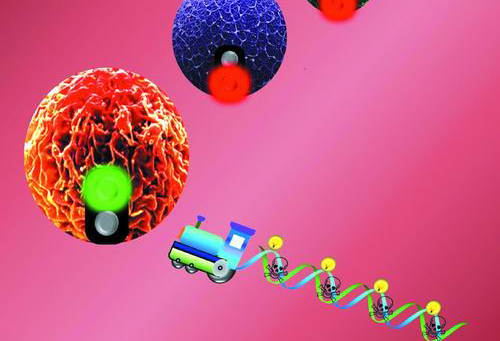湖南大学谭蔚泓研发DNA“纳米火车”靶向大量递送抗癌药
| 导读 | 纳米技术在肿瘤的诊断与治疗方面具有广泛的应用前景。纳米载体能够大大提高靶向释药的剂量和精确度以及降低毒副反应,从而在人体无创的状态下更有效地治疗肿瘤。最近,中国科学家在利用纳米技术治疗肿瘤方面取得了新的研究成果。
DNA“纳米火车”靶向大量递送抗癌药
湖南大学化学生物传感与计量学国家重点实验室主任谭蔚泓带领课题组,研发出一种能向肿瘤细胞靶向输送... |
纳米技术在肿瘤的诊断与治疗方面具有广泛的应用前景。纳米载体能够大大提高靶向释药的剂量和精确度以及降低毒副反应,从而在人体无创的状态下更有效地治疗肿瘤。最近,中国科学家在利用纳米技术治疗肿瘤方面取得了新的研究成果。

湖南大学化学生物传感与计量学国家重点实验室主任谭蔚泓带领课题组,研发出一种能向肿瘤细胞靶向输送大量抗癌药物的DNA“纳米火车”。其不仅可提高抗癌药物的靶向性,减少药物的毒副作用,还可大大增加药物的携带量。相关成果发表于美国《国家科学院院刊》。
据了解,这种“纳米火车”的“车体”由多条DNA短单链通过分子自组装而成,宽约3至5纳米,长度可视需要增减。其整体结构十分简单,三维结构形似火车。它的“火车头”由核酸适配体构成,可与某种特定癌细胞的膜蛋白结合,为给药系统提供“方向”和“动力”;通过分子自组装形成的DNA结构则构成了一节一节的高容量“车厢”,用于装载抗癌药物分子或其他生物试剂,比如可装载荧光成像试剂,对整个过程进行实时监测。
该“纳米火车”可大幅提高抗癌药物的携带量。由于传统给药系统是“一个萝卜一个坑”,一次往往只能携带一个药物分子,不足以杀死癌细胞。采用“火车”式设计,则可一次性携带约300至1000个药物分子。这有助于缩短病人的治疗周期,降低治疗成本。
同时,由于核酸适配体可与目标物质或细胞高特异性地结合,由它构成的“火车头”可精准地将药物输送至癌变区域,从而避免对正常细胞的“误伤”,精准性大大高于传统的化学抗癌药物。此外,由于整列“火车”由生物分子组成,不存在传统的无机或高分子材料在生物体内难降解的问题,从而减少了对人体潜在的毒副作用。
谭蔚泓透露说,该团队已针对白血病、肺癌、乳腺癌、胰腺癌和肝癌等癌细胞的特有生物标志物,筛选出不同的核酸适配体。这意味着运用“纳米火车”成果,将来还有望开发出一次靶向不同类型癌症的“多弹头”药物。
原文链接:
Self-assembled, aptamer-tethered DNA nanotrains for targeted transport of molecular drugs in cancer theranostics
Nanotechnology has allowed the construction of various nanostructures for applications, including biomedicine. However, a simple target-specific, economical, and biocompatible drug delivery platform with high maximum tolerated doses is still in demand. Here, we report aptamer-tethered DNA nanotrains (aptNTrs) as carriers for targeted drug transport in cancer therapy. Long aptNTrs were self-assembled from only two short DNA upon initiation by modified aptamers, which worked like locomotives guiding nanotrains toward target cancer cells. Meanwhile, tandem “boxcars” served as carriers with high payload capacity of drugs that were transported to target cells and induced selective cytotoxicity. aptNTrs enhanced maximum tolerated dose in nontarget cells. Potent antitumor efficacy and reduced side effects of drugs delivered by biocompatible aptNTrs were demonstrated in a mouse xenograft tumor model. Moreover, fluorophores on nanotrains and drug fluorescence dequenching upon release allowed intracellular signaling of nanotrains and drugs. These results make aptNTrs a promising targeted drug transport platform for cancer theranostics.

来源:中国科学报

DNA“纳米火车”靶向大量递送抗癌药
湖南大学化学生物传感与计量学国家重点实验室主任谭蔚泓带领课题组,研发出一种能向肿瘤细胞靶向输送大量抗癌药物的DNA“纳米火车”。其不仅可提高抗癌药物的靶向性,减少药物的毒副作用,还可大大增加药物的携带量。相关成果发表于美国《国家科学院院刊》。
据了解,这种“纳米火车”的“车体”由多条DNA短单链通过分子自组装而成,宽约3至5纳米,长度可视需要增减。其整体结构十分简单,三维结构形似火车。它的“火车头”由核酸适配体构成,可与某种特定癌细胞的膜蛋白结合,为给药系统提供“方向”和“动力”;通过分子自组装形成的DNA结构则构成了一节一节的高容量“车厢”,用于装载抗癌药物分子或其他生物试剂,比如可装载荧光成像试剂,对整个过程进行实时监测。
该“纳米火车”可大幅提高抗癌药物的携带量。由于传统给药系统是“一个萝卜一个坑”,一次往往只能携带一个药物分子,不足以杀死癌细胞。采用“火车”式设计,则可一次性携带约300至1000个药物分子。这有助于缩短病人的治疗周期,降低治疗成本。
同时,由于核酸适配体可与目标物质或细胞高特异性地结合,由它构成的“火车头”可精准地将药物输送至癌变区域,从而避免对正常细胞的“误伤”,精准性大大高于传统的化学抗癌药物。此外,由于整列“火车”由生物分子组成,不存在传统的无机或高分子材料在生物体内难降解的问题,从而减少了对人体潜在的毒副作用。
谭蔚泓透露说,该团队已针对白血病、肺癌、乳腺癌、胰腺癌和肝癌等癌细胞的特有生物标志物,筛选出不同的核酸适配体。这意味着运用“纳米火车”成果,将来还有望开发出一次靶向不同类型癌症的“多弹头”药物。
原文链接:
Self-assembled, aptamer-tethered DNA nanotrains for targeted transport of molecular drugs in cancer theranostics
Nanotechnology has allowed the construction of various nanostructures for applications, including biomedicine. However, a simple target-specific, economical, and biocompatible drug delivery platform with high maximum tolerated doses is still in demand. Here, we report aptamer-tethered DNA nanotrains (aptNTrs) as carriers for targeted drug transport in cancer therapy. Long aptNTrs were self-assembled from only two short DNA upon initiation by modified aptamers, which worked like locomotives guiding nanotrains toward target cancer cells. Meanwhile, tandem “boxcars” served as carriers with high payload capacity of drugs that were transported to target cells and induced selective cytotoxicity. aptNTrs enhanced maximum tolerated dose in nontarget cells. Potent antitumor efficacy and reduced side effects of drugs delivered by biocompatible aptNTrs were demonstrated in a mouse xenograft tumor model. Moreover, fluorophores on nanotrains and drug fluorescence dequenching upon release allowed intracellular signaling of nanotrains and drugs. These results make aptNTrs a promising targeted drug transport platform for cancer theranostics.

来源:中国科学报
 腾讯登录
腾讯登录
还没有人评论,赶快抢个沙发